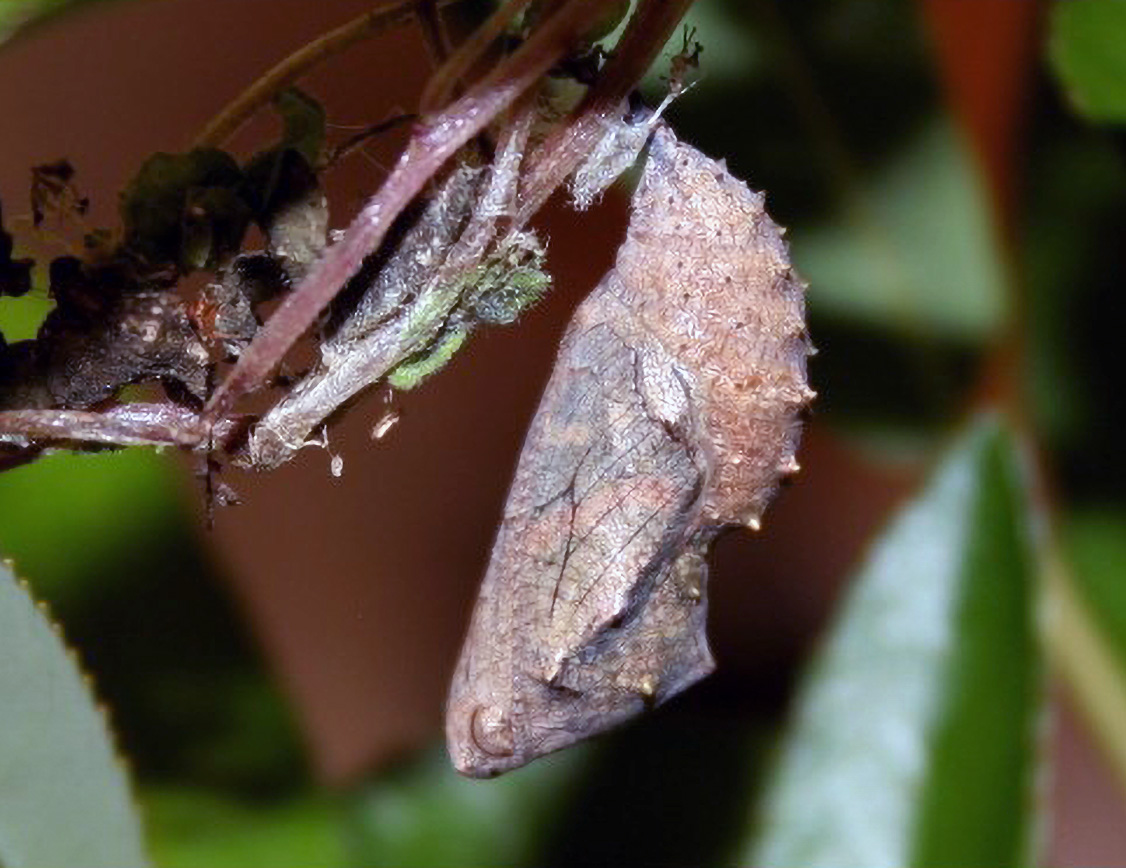The Red Admiral Butterfly - Vanessa atalanta
If you are walking through a park on a sunny day or working in your garden you might have encountered some of these brightly-colored chaotic fliers flutter past you and even land on your clothing – these feisty but people-friendly butterflies are one of the most common species seen in North America and across the world.
 Adult Red Admiral - Photo Credit: Shady Oak Butterfly FarmThe Red Admiral butterfly (Vanessa atalanta) has a distribution that covers North and South America, Europe, and Asia. The diverse range of this butterfly corresponds to an equally diverse set of larval host plants used by this species. Red Admirals use all members of the nettles family (Urticaceae) as their host plants. This includes more than 50 different plant genera – far broader than other common butterflies like Monarchs that use only milkweeds. Nettles are distributed globally and are a successful plant group that commonly has a weedy habit. Finding these plants in urban or disturbed landscapes is not uncommon and they are perhaps why the Red Admiral is the most popular butterfly sighted in urban landscapes.
Adult Red Admiral - Photo Credit: Shady Oak Butterfly FarmThe Red Admiral butterfly (Vanessa atalanta) has a distribution that covers North and South America, Europe, and Asia. The diverse range of this butterfly corresponds to an equally diverse set of larval host plants used by this species. Red Admirals use all members of the nettles family (Urticaceae) as their host plants. This includes more than 50 different plant genera – far broader than other common butterflies like Monarchs that use only milkweeds. Nettles are distributed globally and are a successful plant group that commonly has a weedy habit. Finding these plants in urban or disturbed landscapes is not uncommon and they are perhaps why the Red Admiral is the most popular butterfly sighted in urban landscapes.
With appropriate larval habitats in almost every landscape it is no surprise that Vanessa atalanta is so common. In the wild, V. atalanta are commonly found in moist areas near forest – these species are wetland, bog, and fen species. V. atalanta need water, minerals, and sugars to survive, making wetlands in forest ecosystems ideal habitats.
Adult Red Admiral Butterflies have an open wingspan that ranges in size from 1 3/4 - 3 inches (4.5 - 7.6 cm). Their background coloring is black, with a striking orange to red colored stripes creating marginal bands on the fore and hind wings. Their forewings also have white stops at the apex. Red Admirals live in varied parts of the world and have developed local lifestyles that help them survive in each.
Although they don’t resemble Monarch butterflies, at first glance they are often confused as they sport the same mix of orange, white, and black. Monarchs are much larger than Red Admirals. There is also quite a bit of variety in the genus Vanessa which also includes V. cardui, the Painted Lady; V. virginiensis, American Lady; V. annabella, West Coast Lady; V. tameamea, Kamehameha Butterfly and V. kershawi, the Australian Painted Lady. Painted Lady, West Coast Lady, and American Lady butterflies are more easily confused with Monarchs because their patterns and coloration are more variegated and patchier.
 Red Admiral chrysalis - Photo Credit: Shady Oak Butterfly Farm
Red Admiral chrysalis - Photo Credit: Shady Oak Butterfly Farm
Male Red Admirals are highly territorial, which is why they are commonly encountered chasing each other from their preferred roosting spots. These butterfly dances aren’t playful mates before an encounter – they are jealous rivals that chase anything and everything out of their way, but with the clumsy flutter of a butterfly. Breeding season occurs from late spring into early summer.
Life Cycle and Migration
In North America there are two broods produced between March and October. Red Admiral eggs are green to cream in color and are covered in small hair-like structures, camouflaging on nettle leaves. Once they hatch the larva feed off the leaves of their host plant and grow to a length of about 1 ¼ inches (3.5 cm). When they are ready to pupate, they build a hanging chrysalis under the shade of a leaf that mimics the colors and textures of a dry, dead leaf, once again camouflaging with their surroundings. Unlike Monarch butterflies and others that have chemical defense that they can signal to potential predators with warming coloration, the Red Admirals are unprotected and must hide from the keen eyes of predators like birds. V. atalanta adults visit many flowers for nectar, but like other butterflies, also drink from moist water sources that provide minerals and electrolytes – this is called wicking. Butterflies can commonly be seen wicking near muddy puddles of water. Red Admirals are also known to drink tree sap and even wick from dung.
Butterflies that live in more northern latitudes migrate to the Southern states, like Texas, to avoid a loss of food resources in the winter. This migration is not as renowned as the journey that Monarchs takes across the continent but is a response of local populations seeking food sources throughout the year. Climate change patterns are expected to impact insect species that track plant populations – it will be interesting to see how the Red Admiral responds given its broad host plant range and geographic reach. As of yet, the species and genus is broadly distributed and in good ecological health, but, as with all pollinators, the loss of habitat can significantly impact species survival. These generalist feeders can be supported by planting nettles in gardens and providing other nectar plants throughout the year.

